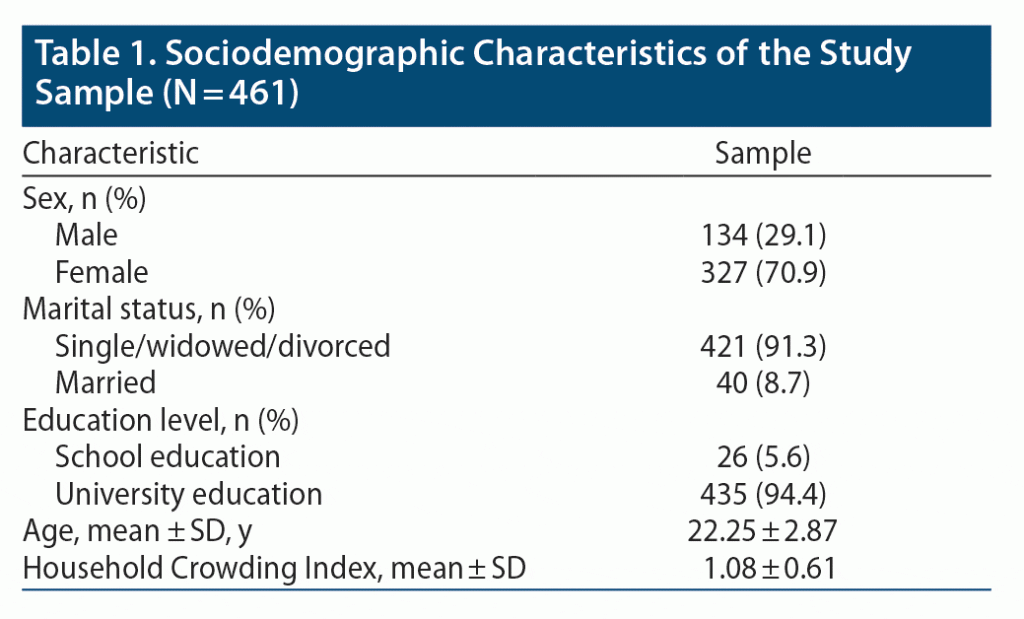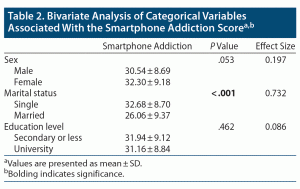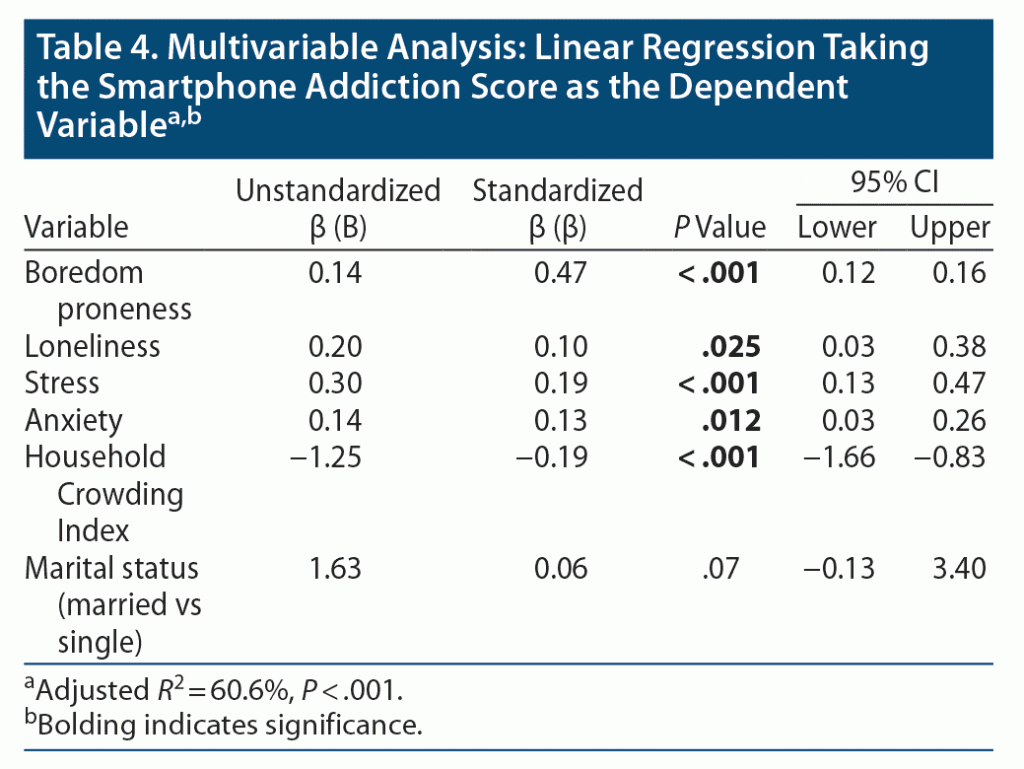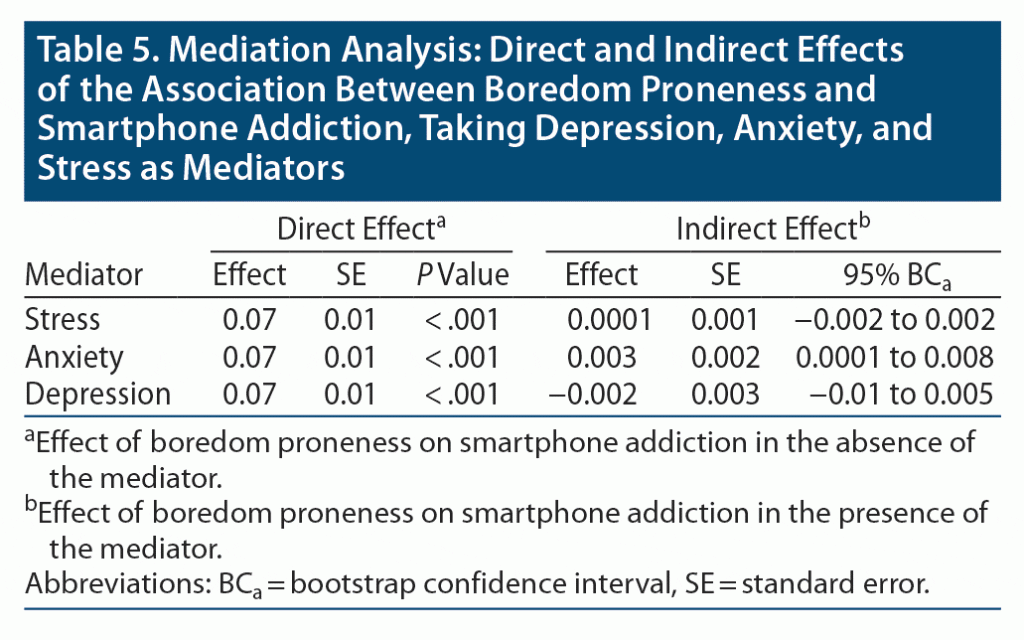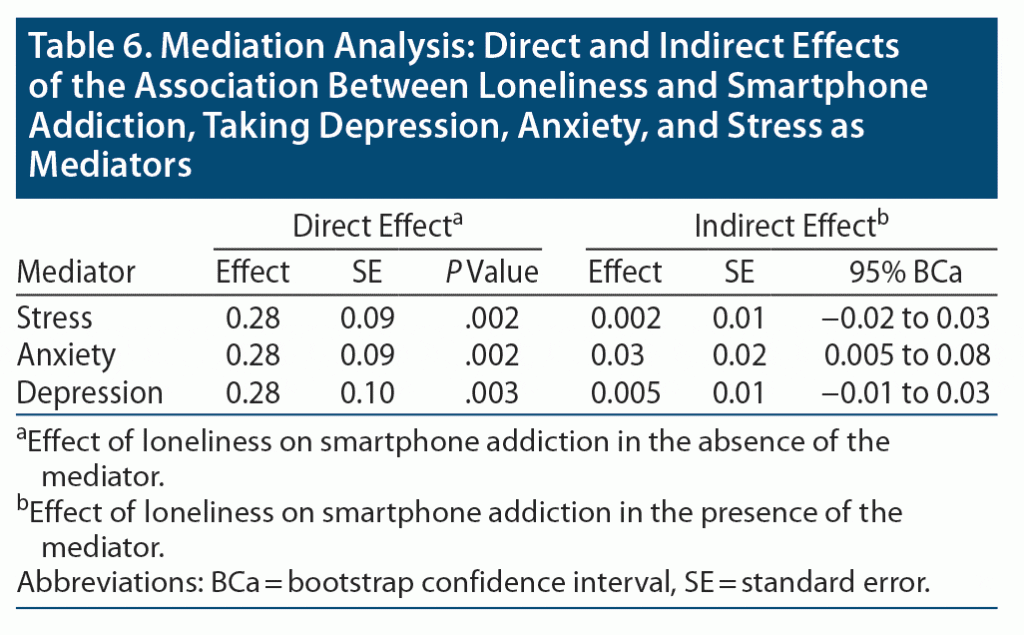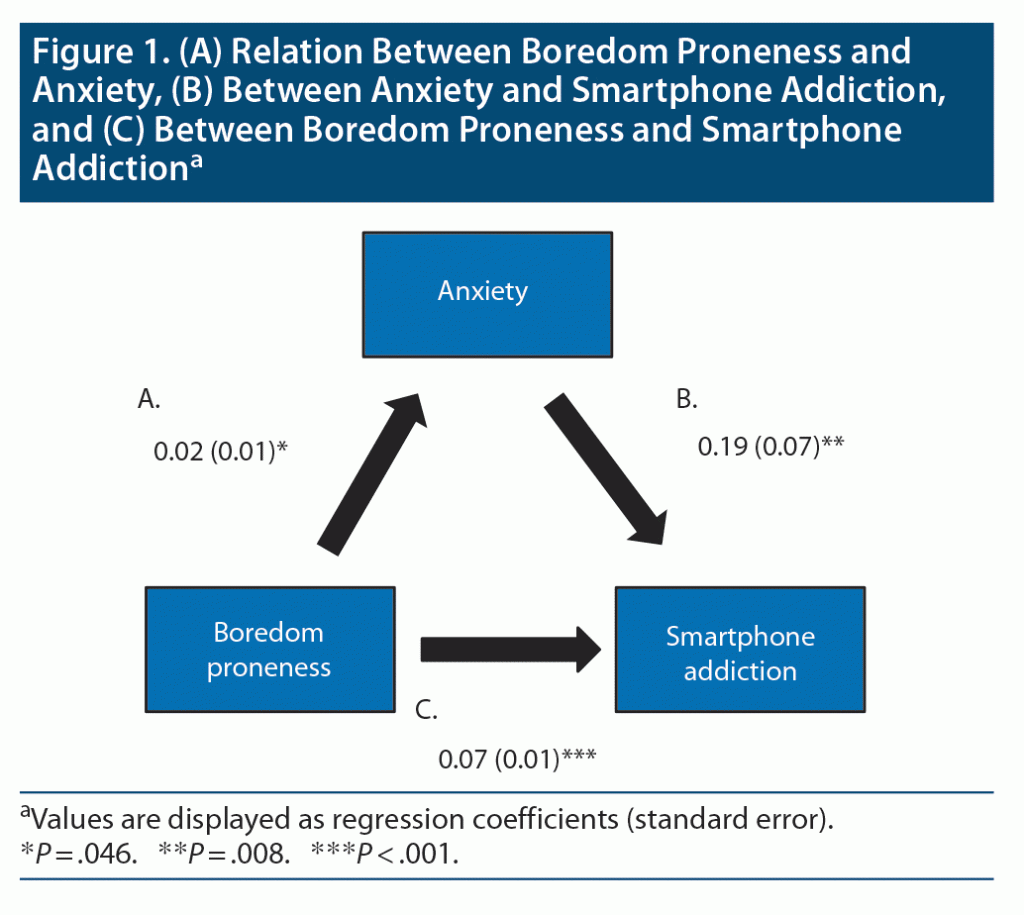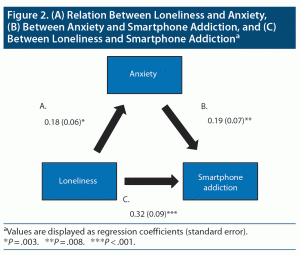ABSTRACT
Objective: To evaluate the association between boredom proneness, loneliness, and smartphone addiction among Lebanese young adults and examine the mediating role of depression, anxiety, and stress in this association.
Methods: This cross‐sectional study was conducted between August and September 2020 during the lockdown period of the coronavirus disease 2019 pandemic. An online survey was completed by 461 young adults aged 18 to 29 years.
Results: The results showed that 66 of 134 males (49.3%, scores ≥ 31) and 143 of 327 females (43.7%, scores ≥ 33) had smartphone addiction. Smartphone addiction was significantly associated with higher boredom proneness (P < .001), anxiety (P = .012), and loneliness (P = .025). Anxiety mediated the association between boredom proneness and smartphone addiction and between loneliness and smartphone addiction, whereas depression and stress did not mediate the association between boredom/loneliness and smartphone addiction.
Conclusions: Smartphone addiction is highly associated with psychological disorders, and screening strategies are needed to minimize addiction. This study emphasizes the importance of investigating the relation between smartphone addiction and psychological disorders.
Prim Care Companion CNS Disord 2022;24(6):21m03092
To cite: Malaeb D, Akel M, Salameh P, et al. Boredom proneness, loneliness, and smartphone addiction among Lebanese young adults: the mediating role of depression, anxiety, and stress. Prim Care Companion CNS Disord. 2022;24(6):21m03092.
To share: https://doi.org/10.4088/PCC.21m03092
© 2022 Physicians Postgraduate Press, Inc.
aCollege of Pharmacy, Gulf Medical University, Ajman, United Arab Emirates
bSchool of Pharmacy, Lebanese International University, Beirut, Lebanon
cINSPECT-LB: Institut National de Santé Publique, Épidémi- ologie Clinique et Toxicologie, Beirut, Lebanon
dSchool of Medicine, Lebanese American University, Byblos, Lebanon
eDepartment of Primary Care and Population Health, University of Nicosia Medical School, Nicosia, Cyprus
fFaculty of Pharmacy, Lebanese University, Hadat, Lebanon
gSchool of Medicine and Medical Sciences, Holy Spirit University of Kaslik, Jounieh, Lebanon
hResearch Department, Psychiatric Hospital of the Cross, Jal Eddib, Lebanon
iSocial and Education Sciences Department, School of Arts and Sciences, Lebanese American University, Jbeil, Lebanon
‡Last co-authors.
*Corresponding authors: Souheil Hallit, PharmD, MSc, MPH, PhD, School of Medicine and Medical Sciences, Holy Spirit University of Kaslik, PO Box 446, Jounieh, Lebanon ([email protected]) and Sahar Obeid, PhD, Social and Education Sciences Department, School of Arts and Sciences, Lebanese American University, Jbeil, Lebanon ([email protected]).
Smartphones are ubiquitous in society, and the prevalence of use among adults is 77% in the United States and 59% globally.1 Smartphones offer many advantages including boosting productivity among employees, facilitating mobile access to calendars, building social capital, easing information retrieval through web searching, and enhancing the learning process among students.2–5 In addition, smartphones are often used for entertainment, as they are portable and easily accessible.6 Moreover, smartphones provide easy access to electronic platforms and applications such as Instagram, Facebook, and WhatsApp, which are considered an integral part of everyday life.7 The excessive use of smartphones among young adults can be explained by the services they offer, low cost compared to other devices, and mobile access to many different types of content.8–10 These social network applications are designed specifically to encourage increased usage, with recent statistics showing that 81% and 69% of Americans report using YouTube and Facebook, respectively.11 Higher social media use was found to lower self-esteem12,13 and to be associated with lower memory performance14 and addiction (alcohol and smoking).15
Despite the advantages of smartphones, addiction is one of the numerous adverse consequences that may arise from overreliance on the device, although there is no consensus on the terms used to describe addiction.10,16,17 Smartphone addiction is an overwhelming obsession with the use of smartphones, regardless of the detrimental consequences to the addicted person and the surrounding community.18 According to recent literature,19 it is considered a specific online addiction that shares similar features with generalized internet addiction but is related to poor health outcomes. Gradually, users fall into a pattern of repetitive behavior arising from emergent rewards and subsequent mood enhancement. The level of psychological dependency increases if the repetitive behavior is reinforced, resulting in addiction.20 Those most vulnerable to addiction are often neglected or have a poor social life.21
Young adults are at higher risk of developing smartphone addiction and are more vulnerable to addictive behaviors, especially in the absence or limited monitoring of smartphone use.22–24 Previous research assessed the association between smartphone addiction and various activities such as videogame addiction,25 excessive exercise,26 online sex addiction,27 excessive appetite,28 compulsive shopping,29,30 workaholism,31 and Internet addiction.32–36 One study37 analyzed the association of psychosocial symptoms (attention problems, physical problems, anxiety and depression, and social problems) and internet addiction.
Research has shown that boredom, loneliness, anxiety, stress, and depression increase the propensity to develop smartphone addiction.38–43 Individuals with concurrent psychological problems use their smartphones to build relationships and satisfy the feeling of belonging.38,39 Boredom proneness, defined as an inability to engage and maintain attention on any object despite being free to do so, was found to be associated with higher smartphone addiction,44 similar to anxiety and depression.45,46 Excessive smartphone use was also shown to have a negative psychological effect characterized by increased vulnerability to stress.47
Previous studies48–51 found that individuals diagnosed with addictions such as smartphone addiction had notable psychological disorders such as poor sleep quality, stress, anxiety, and depression. Furthermore, research conducted in Lebanon showed that depression and anxiety were positive predictor factors of smartphone addiction.52
Research has established a connection between various mediating factors and smartphone addiction.48–51 The presence of psychological disorders is a common variable in the existing research on addictive behaviors, including smartphone addiction, and suggests the possibility of anxiety and depression playing an intermediate role between loneliness, boredom proneness, and smartphone addiction. Thus, the objective of this study was to evaluate the association between boredom proneness, loneliness, and smartphone addiction among Lebanese young adults and examine the mediating role of depression, anxiety, and stress in this association.
METHODS
General Study Design
A cross-sectional study was conducted between August and September 2020 during the lockdown period imposed by the government for the COVID-19 pandemic, which also coincides with the summer vacation season for most Lebanese citizens. The sample was comprised of community-dwelling participants aged 18 to 29 years. Due to the restrictions on gatherings and the impracticality and risk associated with face-to-face interviews, a survey was created in Google forms as a link. The link was shared among participants from all districts/governorates of Lebanon (Beirut, Mount Lebanon, North Lebanon, South Lebanon, and Bekaa) using the snowball technique. Participants were asked to fill out the survey online and send the link to other friends and family members. All participants who had a mobile phone were eligible to participate. This study shares the same methodology as that of previous research.53–55
Minimal Sample Size Calculation
According to the G-power software and based on an effect size of f2 = 2%, an α error of 5%, a power of 80%, and taking into consideration 10 factors to be entered in the multivariable analysis, the results showed that a minimal number of 395 was needed.
Translation Procedure
The scales were forward and back translated. Forward translation (English to Arabic) was performed by 1 translator, whereas the back translation from Arabic to English was performed by another translator. Minor discrepancies were solved by consensus. A pilot study was conducted with 15 people to ensure all questions were clear and understandable, and no subsequent changes were made. Data related to participants of the pilot study were included in the final database.
Questionnaire and Variables
The self-administered questionnaire with closed-ended questions was anonymous, available in Arabic and English, and required approximately 25–30 minutes to complete. An introduction explained the objectives of the study and asked for informed consent from the participants. The first section assessed sociodemographic characteristics such as age, sex, marital status, education level, and Household Crowding Index (HCI).56 The HCI reflects the socioeconomic status of the family and was calculated by dividing the number of persons in the house by the number of rooms in the house, excluding the bathrooms and kitchen. The higher the HCI, the lower the socioeconomic status.56 The second part of the questionnaire included the following scales.
Smartphone Addiction Scale
Validated in Lebanon,57 the Smartphone Addiction Scale (SAS) is a 10-item scale used to evaluate smartphone addiction among South Korean adolescents58 and Chinese adults.59 The total score was computed by adding the answers of these 10 items, with higher scores reflecting higher smartphone addiction. The cutoff value for determining the presence of smartphone addiction in the original study was 31 in boys and 33 in girls.58 In this study, the SAS Cronbach α was 0.886.
Short Boredom Proneness Scale
The Short Boredom Proneness Scale60 is used to evaluate boredom proneness. It includes 28 items with a 6-point Likert scale: 1 (strongly disagree) and 6 (strongly agree) based on self-reporting. The total score is calculated by summing the 28 items. Higher scores indicate higher boredom proneness. In this study, the Cronbach α was 0.935.
Beirut Distress Scale
The Beirut Distress Scale61 is a 10-item stress assessment instrument. The scale asks about feelings and thoughts during the last month, with answers measured on a 4-point Likert scale: 0 (never) to 3 (very often). Higher scores indicate higher perceived stress. The Cronbach α was 0.877.
Montgomery-Asberg Depression Rating Scale
The Montgomery-Asberg Depression Rating Scale,62 validated in Lebanon,63 is a 10-item scale that evaluates the core symptoms of depression by focusing on mood symptoms such as sadness, tension, pessimism, and suicidal thoughts. Responses are graded from 0, indicating no abnormality, to 6, indicating more depressive symptoms. The Cronbach α was 0.822.
Lebanese Anxiety Scale
The Lebanese Anxiety Scale64 screens for anxiety in adults, and higher scores indicate more anxious attitude. The Cronbach α for this scale was 0.886.
Jong-Gierveld Loneliness Scale
Subjective loneliness was assessed with the modified version of the Jong-Gierveld Loneliness Scale, comprised of 5 items.65 One point is given for a “yes” answer and zero for a “no” answer. Higher scores indicate more loneliness. The Cronbach α was α = 0.815.
Statistical Analysis
SPSS software version 23 was used to conduct the data analysis. We had no missing data, since all questions were required in the Google form. Weighting to the general population was done according to sex and education level. The normality of distribution of the SAS score was confirmed via a calculation of the skewness and kurtosis; values for asymmetry and kurtosis between −1 and +1 are considered acceptable to prove normal univariate distribution.66 These conditions consolidate the assumptions of normality in samples larger than 300.67 The Student t and analysis of variance tests were used to compare 2 and ≥ 3 means, respectively, whereas the Pearson correlation test was used to compare 2 continuous variables. A forward linear regression was conducted to check for correlates associated with smartphone addiction. Cronbach α values were recorded for reliability analysis of all scales and subscales. Significance was set at P < .05.
Mediation Analysis
The PROCESS SPSS Macro version 3.4 model 468 was used to calculate 3 pathways. Pathway A determined the regression coefficient for the effect of boredom/loneliness on depression/anxiety/stress, pathway B examined the association between depression/anxiety/stress on smartphone addiction, and pathway C estimated the total and direct effect of boredom/loneliness on smartphone addiction. Pathway AB calculated the indirect intervention effects. To test the significance of the indirect effect, the macro generated bias-corrected bootstrapped 95% CIs.68 A significant mediation was determined if the CI around the indirect effect did not include zero.68 All factors that showed an effect size or correlation > 0.24 in the bivariate analysis were entered as independent variables in the linear and mediation models to have parsimonious models.69 Significance was set at P < .05.
RESULTS
Sociodemographic and Other Characteristics
The results showed that the mean ± SD age of the participants was 22.25 ± 2.87 years, with 70.9% female. Almost all the participants were single (91.3%) and had a university education level (94.4%). The mean ± SD HCI was 1.08 ± 0.61 (Table 1). In addition, the mean ± SD scores of the scales were smartphone addiction: 31.19 ± 8.80, boredom proneness: 107.48 ± 30.20, loneliness: 13.66 ± 4.50, stress: 12.11 ± 6.63, anxiety: 13.91 ± 7.51, and depression: 15.92 ± 10.83. The results showed that 66 of 134 males (49.3%, scores ≥ 31) and 143 of 327 females (43.7%, scores ≥ 33) had smartphone addiction.
Bivariate Analysis
The bivariate analysis results are summarized in Table 2 and Table 3. Higher boredom proneness, loneliness, stress, anxiety, and HCI were significantly associated with more smartphone addiction. Single participants had more smartphone addiction than those who were married.
Multivariable Analysis
The results of the linear regression (using the enter method), taking smartphone addiction as the dependent variable, showed that more boredom proneness (B = 0.14), loneliness (B = 0.20), stress (B = 0.30), and anxiety (B = 0.14) were significantly associated with more smartphone addiction, whereas higher HCI (B = −1.25) was significantly associated with less smartphone addiction (Table 4).
Mediation Analysis
The results of the mediation analysis are summarized in terms of direct and indirect effects in Table 5 and Table 6 and in terms of regression coefficients and standard errors in Figure 1 and Figure 2. Anxiety mediated the association between boredom proneness and smartphone addiction and between loneliness and smartphone addiction, whereas depression and stress did not mediate those associations.
DISCUSSION
The study results showed that higher boredom proneness, anxiety, and loneliness were significantly associated with higher smartphone addiction. On the other hand, anxiety, but not depression or stress, mediated the association between boredom proneness and smartphone addiction and between loneliness and smartphone addiction. We note that the study was conducted during the COVID-19 lockdown, and previous literature highlighted that smartphone addiction was high during the pandemic.70,71
Boredom Proneness and Smartphone Addiction
Boredom proneness was significantly associated with higher smartphone addiction in this study, which is consistent with the results of previous literature.72 Sommers and Vodanovich73 found that boredom proneness is highly linked with psychological health indices such as anxiety and depression. It is documented that high internet use and greater access to communication and entertainment through smartphones increase psychological problems and the core characteristics of boredom.74 Avoiding feelings of boredom, seeking excitement and pleasure, and socializing through social media seem to be the main trigger factors for internet misuse and thus smartphone addiction.75 In addition, it was previously shown that depression, anxiety, and interpersonal sensitivity can lead to a greater susceptibility to boredom and higher risk of excessive use of online communication applications.72 This behavior is further increased mainly when individuals encounter smartphone stimuli that provide an extraordinary experience and desire to use the smartphone after seeing or listening to the sound of an incoming message.76 Thus, users of online communication applications develop smartphone addiction as a means to cope with unpleasant feelings such as boredom and to escape from the understimulation.
Anxiety and Smartphone Addiction
In our study, anxiety was significantly associated with higher smartphone addiction, in agreement with a study conducted by Demirci et al.51 Excessive smartphone use coupled with negative attitudes and feelings of anxiety and dependence may increase the risk for depression.45,77 Jones et al46 concluded that students’ addiction to their mobile phones seems to be high and that excessive use had a negative psychological effect. Also, a study52 conducted with Lebanese undergraduate students showed that both depression and anxiety were positive predictors of smartphone addiction. The user’s emotional attachment to mobile phones is considered a means of survival, exerting both physical and mental deterioration, including anxiety. Specifically, the addiction to text messages is highly associated with anxiety, nervousness, and unstable personality traits.78
Loneliness and Smartphone Addiction
In this study, loneliness was significantly associated with higher smartphone addiction, which is consistent with a study conducted by Bhardwaj and Ashok.79 On the other hand, Takao et al80 found no relation between loneliness and smartphone addiction. Smartphone use and loneliness have a strong positive relation because smartphone use provides the opportunity for social links and connections between people with limited social lives, since their social ties are increasingly spatially dispersed.81
Thus, use of smartphones maintains bonds, creates new connections, aids in coping with various challenges, and is considered a means to combat the fear of missing out.82 People who experience the fear of missing out rely heavily on smartphones to access social networks so as not to miss something on the sites or the activities of others.83 Smartphones are often used to obtain emotional support and alleviate negative feelings including loneliness.84,85 In addition, smartphone addicts who spend a lot of time on their phones are forced to reduce their face-to-face contact time and thus have poor social support and higher levels of loneliness.86 Therefore, the higher the loneliness, the greater the likelihood of smartphone addiction.87
Mediation of Depression, Anxiety, and Stress Between Smartphone Addiction, Loneliness, and Boredom Proneness
In our study, anxiety, but not depression or stress, partially mediated the relation between smartphone addiction, boredom proneness, and loneliness. A previous study72 found that anxiety mediated the relation between boredom proneness and problematic smartphone use severity. The explanation for the mediating effect of anxiety is that anxious individuals compensate for their negative emotions and loneliness by engaging in increased smartphone use and consequently addiction. However, no past study has examined the possible mediating effect of depression and stress between smartphone addicts and boredom proneness, yet both variables were found to be significantly related to higher smartphone addiction.16 In addition, a combination of stress and psychological dysregulation such as depression and anxiety predispose individuals to behavioral addiction.88 Conversely, previous findings showed that boredom proneness mediates the associations between both depression and anxiety with problematic smartphone use.89
Clinical Implications
Our findings emphasize the importance of investigating the relation between smartphone addiction and psychological disorders. Smartphone addiction should become a target interest among young adults, as they are at higher risk for addiction. Given that smartphone addiction is a novel introduction to the addictive behavior domain, its significant association with psychological disorders requires serious consideration in the community setting.
Limitations
This study was conducted using a survey that relies on self‐reported behavior assessment through questionnaires reflecting the interviewee’s own perspective and is suitable only for evaluating subjective disorders.90 In addition, due to the cross‐sectional nature of this study, causality cannot be determined, and there was no evaluation of the symptoms before and after the lockdown. A major limitation is that the study was conducted during the COVID-19 lockdown, and research indicates that internet addiction including smartphone use was particularly high during this time.71 Furthermore, the study sample is not representative of the whole Lebanese population (ie, low mean age, high number of female participants, most had a university education level). The Smartphone Addiction Scale, Short Boredom Proneness Scale, and Jong-Gierveld Loneliness Scale have not been validated in Lebanon. Residual confounding bias is possible, since not all factors associated with smartphone addiction were considered in this study. Selection bias is also present because of the snowball sampling technique used.
CONCLUSION
The study findings indicate that boredom proneness, loneliness, and anxiety were associated with higher smartphone addiction. The results confirm that anxiety, but not depression or stress, mediated the association between boredom proneness and smartphone addiction and between loneliness and smartphone addiction. Further investigations should focus on examining the relation between smartphone addiction and mental health, which could clarify why the use of smartphones can be beneficial for some people, while exposing others to the risk of developing psychological disorders.
Submitted: August 9, 2021; accepted November 24, 2021.
Published online: November 8, 2022.
Relevant financial relationships: None.
Funding/support: None.
Acknowledgments: The authors thank Carla Abi Doumit, MD (School of Medicine and Medical Sciences, Holy Spirit University of Kaslik, Jounieh, Lebanon) for help with the data collection and all participants in the study. Dr Abi Doumit has no relevant financial relationships to disclose.
Clinical points
- Smartphone addiction was significantly associated with higher boredom proneness, anxiety, and loneliness.
- Anxiety mediated the association between boredom proneness and smartphone addiction and between loneliness and smartphone addiction; depression and stress did not mediate those associations.
- Smartphone addiction is highly associated with psychological disorders, and screening strategies are needed to minimize addiction.
References (90)

- Poushter J, Bishop C, Chwe H. Social media use continues to rise in developing countries but plateaus across developed ones. Pew Research Center. 2018;19(22):2–19.
- Lee KY, Lee M, Kim K. Are smartphones helpful? an empirical investigation of the role of smartphones in users’ role performance. Int J Mobile Communications. 2017;15(2):119–143. CrossRef
- Bertschek I, Niebel T. Mobile and more productive? firm-level evidence on the productivity effects of mobile internet use. Telecomm Policy. 2016;40(9):888–898. CrossRef
- Remón J, Sebastián V, Romero E, et al. Effect of using smartphones as clickers and tablets as digital whiteboards on students’ engagement and learning. Active Learn High Educ. 2017;18(2):173–187. CrossRef
- George TP, DeCristofaro C. Use of smartphones with undergraduate nursing students. J Nurs Educ. 2016;55(7):411–415. PubMed CrossRef
- Griffiths M. Internet addiction-time to be taken seriously? Addict Res. 2000;8(5):413–418. CrossRef
- Junco R, Cotten SR. No A 4 U: the relationship between multitasking and academic performance. Comput Educ. 2012;59(2):505–514. CrossRef
- Shambare R, Rugimbana R, Zhowa T. Are mobile phones the 21st century addiction? Afr J Bus Manag. 2012;6(2):573–577.
- Massimini M, Peterson M. Information and communication technology: affects on US college students. Cyberpsychology (Brno). 2009;1(3):1.
- Leung H, Pakpour AH, Strong C, et al. Measurement invariance across young adults from Hong Kong and Taiwan among three internet-related addiction scales: Bergen Social Media Addiction Scale (BSMAS), Smartphone Application-Based Addiction Scale (SABAS), and Internet Gaming Disorder Scale-Short Form (IGDS-SF9) (study Part A). Addict Behav. 2020;101:105969. PubMed CrossRef
- Auxier B, Anderson M. Social Media Use in 2021. Pew Research website. Accessed September 20, 2022. https://www.pewresearch.org/internet/2021/04/07/social-media-use-in-2021/
- Jan M, Soomro S, Ahmad N. Impact of social media on self-esteem. Eur Sci J. 2017;13(23):329–341.
- Bitar Z, Hallit S, Khansa W, et al. Phubbing and temperaments among young Lebanese adults: the mediating effect of self-esteem and emotional intelligence. BMC Psychol. 2021;9(1):87. PubMed CrossRef
- Dagher M, Farchakh Y, Barbar S, et al. Association between problematic social media use and memory performance in a sample of Lebanese adults: the mediating effect of anxiety, depression, stress and insomnia. Head Face Med. 2021;17(1):6. PubMed CrossRef
- Awad E, Hallit R, Haddad C, et al. Is problematic social media use associated with higher addictions (alcohol, smoking, and waterpipe) among Lebanese adults? Perspect Psychiatr Care. 2021;ppc.12963. PubMed CrossRef
- Elhai JD, Dvorak RD, Levine JC, et al. Problematic smartphone use: a conceptual overview and systematic review of relations with anxiety and depression psychopathology. J Affect Disord. 2017;207:251–259. PubMed CrossRef
- Walsh S, White K, Young, R. Needing to connect: the effect of self and others on young people’s involvement with their mobile phones. Aust J Psychol. 2010;62(4):194–203. CrossRef
- Alexander MJ, Haugland G, Lin SP, et al. Mental health screening in addiction, corrections and social service settings: validating the MMS. Int J Ment Health Addict. 2008;6(1):105–119. CrossRef
- Chen I-H, Strong C, Lin Y-C, et al. Time invariance of three ultra-brief internet-related instruments: Smartphone Application-Based Addiction Scale (SABAS), Bergen Social Media Addiction Scale (BSMAS), and the nine-item Internet Gaming Disorder Scale-Short Form (IGDS-SF9) (study Part B). Addict Behav. 2020;101:105960. PubMed CrossRef
- Everitt BJ, Robbins TW. Neural systems of reinforcement for drug addiction: from actions to habits to compulsion. Nat Neurosci. 2005;8(11):1481–1489. PubMed CrossRef
- Youssef L, Hallit R, Kheir N, et al. Social media use disorder and loneliness: any association between the two? results of a cross-sectional study among Lebanese adults. BMC Psychol. 2020;8(1):56. PubMed CrossRef
- Mok J-Y, Choi S-W, Kim D-J, et al. Latent class analysis on internet and smartphone addiction in college students. Neuropsychiatr Dis Treat. 2014;10:817–828. PubMed
- Head M, Ziolkowski N. Understanding student attitudes of mobile phone features: rethinking adoption through conjoint, cluster and SEM analyses. Comput Human Behav. 2012;28(6):2331–2339. CrossRef
- Cha S-S, Seo B-K. Smartphone use and smartphone addiction in middle school students in Korea: prevalence, social networking service, and game use. Health Psychol Open. 2018;5(1):2055102918755046. PubMed CrossRef
- Fisher S. Identifying video game addiction in children and adolescents. Addict Behav. 1994;19(5):545–553. PubMed CrossRef
- Adams J, Kirkby RJ. Excessive exercise as an addiction: a review. Addict Res Theory. 2002;10(5):415–437. CrossRef
- Griffiths MD. Internet sex addiction: a review of empirical research. Addict Res Theory. 2012;20(2):111–124. CrossRef
- Orford J. Excessive Appetites: A Psychological View of the Addictions. Wiley; 2001.
- O’Guinn TC, Faber RJ. Compulsive buying: a phenomenological exploration. J Consum Res. 1989;16(2):147–157. CrossRef
- Clark M, Calleja K. Shopping addiction: a preliminary investigation among Maltese university students. Addict Res Theory. 2008;16(6):633–649. CrossRef
- Andreassen CS, Hetland J, Pallesen S. The relationship between ‘workaholism,’ basic needs satisfaction at work and personality. European J Personality. 2010;24(1):3–17. CrossRef
- Young KS. Internet addiction: a new clinical phenomenon and its consequences. Am Behav Sci. 2004;48(4):402–415. CrossRef
- Young KS. Internet addiction: symptoms, evaluation and treatment. In: VandeCreek L, Jackson TL, eds. Innovations in Clinical Practice: A Source Book. Volume 17. Professional Resource Exchange Inc; 1999:351–352.
- Young KS. Psychology of computer use: XL. Addictive use of the internet: a case that breaks the stereotype. Psychol Rep. 1996;79(3 Pt 1):899–902. PubMed CrossRef
- Young KS. Internet addiction: diagnosis and treatment considerations. J Contemp Psychother. 2009;39(4):241–246. CrossRef
- Beard KW. Internet addiction: a review of current assessment techniques and potential assessment questions. Cyberpsychol Behav. 2005;8(1):7–14. PubMed CrossRef
- Atoum A, Hattab L. Internet addiction and its relation to psychosocial adaptation among Jordanian high basic stage students. J Psychol Behav Sci. 2015;3(1):3. CrossRef
- Wu AM, Cheung VI, Ku L, et al. Psychological risk factors of addiction to social networking sites among Chinese smartphone users. J Behav Addict. 2013;2(3):160–166. PubMed CrossRef
- LaRose R, Eastin MS. A social cognitive theory of internet uses and gratifications: toward a new model of media attendance. J Broadcast Electron Media. 2004;48(3):358–377. CrossRef
- De-Sola Gutiérrez J, Rodríguez de Fonseca F, Rubio G. Cell-phone addiction: a review. Front Psychiatry. 2016;7:175. PubMed
- Youssef L, Hallit R, Akel M, et al. Social media use disorder and alexithymia: any association between the two? results of a cross-sectional study among Lebanese adults. Perspect Psychiatr Care. 2021;57(1):20–26. PubMed CrossRef
- Barbar S, Haddad C, Sacre H, et al. Factors associated with problematic social media use among a sample of Lebanese adults: the mediating role of emotional intelligence. Perspect Psychiatr Care. 2021;57(3):1313–1322. PubMed
- Malaeb D, Salameh P, Barbar S, et al. Problematic social media use and mental health (depression, anxiety, and insomnia) among Lebanese adults: any mediating effect of stress? Perspect Psychiatr Care. 2021;57(2):539–549. PubMed CrossRef
- Smilek D, Carriere JSA, Cheyne JA. Out of mind, out of sight: eye blinking as indicator and embodiment of mind wandering. Psychol Sci. 2010;21(6):786–789. PubMed CrossRef
- Rosen LD, Whaling K, Carrier LM, et al. The media and technology usage and attitudes scale: an empirical investigation. Comput Human Behav. 2013;29(6):2501–2511. PubMed CrossRef
- Jones KH, Jones PA, Middleton RM, et al. Physical disability, anxiety and depression in people with MS: an internet-based survey via the UK MS Register. PLoS One. 2014;9(8):e104604. PubMed CrossRef
- Lemola S, Perkinson-Gloor N, Brand S, et al. Adolescents’ electronic media use at night, sleep disturbance, and depressive symptoms in the smartphone age. J Youth Adolesc. 2015;44(2):405–418. PubMed CrossRef
- Cho HY, Kim DJ, Park JW. Stress and adult smartphone addiction: mediation by self-control, neuroticism, and extraversion. Stress Health. 2017;33(5):624–630. PubMed CrossRef
- Ivanova A, Gorbaniuk O, Błachnio A, et al. Mobile phone addiction, phubbing, and depression among men and women: a moderated mediation analysis. Psychiatr Q. 2020;91(3):655–668. PubMed CrossRef
- Xie X, Dong Y, Wang J. Sleep quality as a mediator of problematic smartphone use and clinical health symptoms. J Behav Addict. 2018;7(2):466–472. PubMed CrossRef
- Demirci K, Akgönül M, Akpinar A. Relationship of smartphone use severity with sleep quality, depression, and anxiety in university students. J Behav Addict. 2015;4(2):85–92. PubMed CrossRef
- Matar Boumosleh J, Jaalouk D. Depression, anxiety, and smartphone addiction in university students: a cross sectional study. PLoS One. 2017;12(8):e0182239. PubMed CrossRef
- Sfeir E, Hallit S, Akel M, et al. Smartphone addiction and personality traits among Lebanese adults: the mediating role of self-esteem. Psychol Health Med. 2021:1–11. PubMed CrossRef
- Bitar Z, Hallit S, Khansa W, et al. Phubbing and temperaments among young Lebanese adults: the mediating effect of self-esteem and emotional intelligence. BMC Psychol. 2021;9(1):87. PubMed CrossRef
- Bitar Z, Akel M, Salameh P, et al. Phubbing among Lebanese young adults: scale validation and association with mental health (depression, anxiety, and stress). Curr Psychol. 2022;26:1–12. PubMed CrossRef
- Melki IS, Beydoun HA, Khogali M, et al; National Collaborative Perinatal Neonatal Network (NCPNN). Household Crowding Index: a correlate of socioeconomic status and inter-pregnancy spacing in an urban setting. J Epidemiol Community Health. 2004;58(6):476–480. PubMed CrossRef
- Zeidan J, Hallit S, Akel M, et al. Problematic smartphone use and affective temperaments among Lebanese young adults: scale validation and mediating role of self-esteem. BMC Psychol. 2021;9(1):136. PubMed CrossRef
- Kwon M, Kim D-J, Cho H, et al. The Smartphone Addiction Scale: development and validation of a short version for adolescents. PLoS One. 2013;8(12):e83558. PubMed CrossRef
- Luk TT, Wang MP, Shen C, et al. Short version of the Smartphone Addiction Scale in Chinese adults: psychometric properties, sociodemographic, and health behavioral correlates. J Behav Addict. 2018;7(4):1157–1165. PubMed CrossRef
- Struk AA, Carriere JS, Cheyne JA, et al. A short Boredom Proneness Scale: development and psychometric properties. Assessment. 2017;24(3):346–359. PubMed CrossRef
- Malaeb D, Farchakh Y, Haddad C, et al. Validation of the Beirut Distress Scale (BDS-10), a short version of BDS-22, to assess psychological distress among the Lebanese population. Perspect Psychiatr Care. 2022;58(1):304–313. PubMed
- Sajatovic M, Chen P, Young RC. Rating Scales in Bipolar Disorder. Clinical Trial Design Challenges in Mood Disorders. Elsevier; 2015:105–136.
- Hallit S, Obeid S, El Hage W, et al. Validation of the Arabic version of the MADRS scale among Lebanese patients with depression. Encephale. 2019;45(3):195–199. PubMed CrossRef
- Hallit S, Obeid S, Haddad C, et al. Construction of the Lebanese Anxiety Scale (LAS-10): a new scale to assess anxiety in adult patients. Int J Psychiatry Clin Pract. 2020;24(3):270–277. PubMed CrossRef
- Wilson RS, Krueger KR, Arnold SE, et al. Loneliness and risk of Alzheimer disease. Arch Gen Psychiatry. 2007;64(2):234–240. PubMed CrossRef
- Hair JF Jr, Hult GTM, Ringle C, et al. A Primer on Partial Least Squares Structural Equation Modeling (PLS-SEM). Sage Publications; 2017.
- Mishra P, Pandey CM, Singh U, et al. Descriptive statistics and normality tests for statistical data. Ann Card Anaesth. 2019;22(1):67–72. PubMed CrossRef
- Hayes AF. Introduction to Mediation, Moderation, and Conditional Process Analysis: A Regression-Based Approach. Guilford Publications; 2017.
- Vandekerckhove J, Matzke D, Wagenmakers E-J. Model Comparison and the Principle of Parsimony. University of California: eScholarship; 2014.
- Chen CY, Chen IH, Hou WL, et al. The relationship between children’s problematic internet-related behaviors and psychological distress during the onset of the COVID-19 pandemic: a longitudinal study. J Addict Med. 2022;16(2):e73–e80. PubMed
- Chen CY, Chen IH, Pakpour AH, et al. Internet-related behaviors and psychological distress among schoolchildren during the COVID-19 school hiatus. Cyberpsychol Behav Soc Netw. 2021;24(10):654–663. PubMed CrossRef
- Elhai JD, Vasquez JK, Lustgarten SD, et al. Proneness to boredom mediates relationships between problematic smartphone use with depression and anxiety severity. Soc Sci Comput Rev. 2018;36(6):707–720. CrossRef
- Sommers J, Vodanovich SJ. Boredom proneness: its relationship to psychological- and physical-health symptoms. J Clin Psychol. 2000;56(1):149–155. PubMed CrossRef
- Wegmann E, Ostendorf S, Brand M. Is it beneficial to use internet-communication for escaping from boredom? boredom proneness interacts with cue-induced craving and avoidance expectancies in explaining symptoms of internet-communication disorder. PLoS One. 2018;13(4):e0195742. PubMed CrossRef
- Rahmani S, Lavasani MG. The relationship between internet dependency with sensation seeking and personality. Procedia Soc Behav Sci. 2011;30:272–277. CrossRef
- Wegmann E, Stodt B, Brand M. Cue-induced craving in internet-communication disorder using visual and auditory cues in a cue-reactivity paradigm. Addict Res Theory. 2018;26(4):306–314. CrossRef
- Thomée S, Härenstam A, Hagberg M. Mobile phone use and stress, sleep disturbances, and symptoms of depression among young adults–a prospective cohort study. BMC Public Health. 2011;11(1):66. PubMed CrossRef
- Babadi-Akashe Z, Zamani BE, Abedini Y, et al. The relationship between mental health and addiction to mobile phones among university students of Shahrekord, Iran. Addict Health. 2014;6(3-4):93–99. PubMed
- Bhardwaj M, Ashok MSJ. Mobile phone addiction and loneliness among teenagers. Int J Indian psychol. 2015;2(3):27–34.
- Takao M, Takahashi S, Kitamura M. Addictive personality and problematic mobile phone use. Cyberpsychol Behav. 2009;12(5):501–507. PubMed CrossRef
- Wang D, Xiang Z, Fesenmaier DR. Smartphone use in everyday life and travel. J Travel Res. 2016;55(1):52–63. CrossRef
- Li L, Griffiths MD, Mei S, et al. Fear of missing out and smartphone addiction mediates the relationship between positive and negative affect and sleep quality among Chinese university students. Front Psychiatry. 2020;11:877. PubMed CrossRef
- Tunc-Aksan A, Akbay SE. Smartphone addiction, fear of missing out, and perceived competence as predictors of social media addiction of adolescents. Eur J Educational Res. 2019;8(2):559–569. CrossRef
- Chiu S-I. The relationship between life stress and smartphone addiction on Taiwanese university student: A mediation model of learning self-efficacy and social self-efficacy. Comput Human Behav. 2014;34:49–57. CrossRef
- Hodis GM, Hodis FA. A mediation analysis of international students’ patterns of computer-mediated communication. Int J Commun. 2012;6:24.
- Nie N, Hillygus DS, Erbring L. Internet use, interpersonal relations, and sociability: a time diary study. 2008:213–243.
- Bian M, Leung L. Smartphone addiction: linking loneliness, shyness, symptoms and patterns of use to social capital. Media Asia. 2014;41(2):159–176. CrossRef
- Saadat SH, Hashemi SGS, Garamaleki HB, et al. The explanation of students’ addiction potential based on psychological dysregulation (behavioral, cognitive, and emotional): with perceived stress mediation. J Res Med Dent Sci. 2019;7:116–121.
- Wolniewicz CA, Rozgonjuk D, Elhai JD. Boredom proneness and fear of missing out mediate relations between depression and anxiety with problematic smartphone use. Hum Behav Emerg Technol. 2020;2(1):61–70. CrossRef
- Armstrong D, Dregan A. A population-based investigation into the self-reported reasons for sleep problems. PLoS One. 2014;9(7):e101368. PubMed CrossRef
Please sign in or purchase this PDF for $40.
Save
Cite
